Utah County Birders Newsletter
|
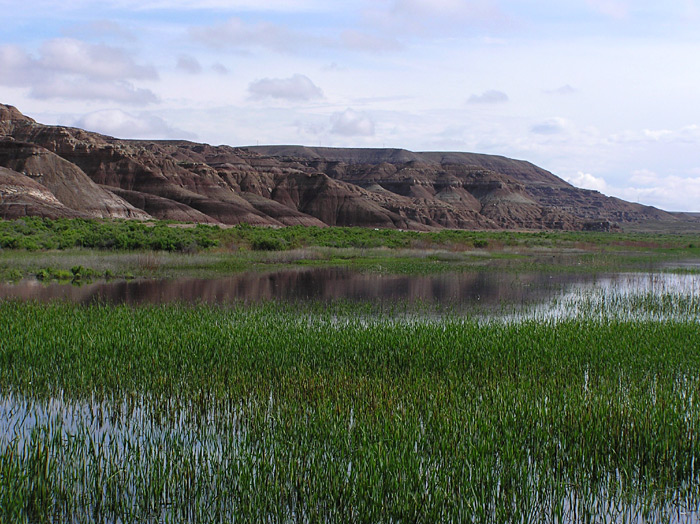 |
|
Ouray NWR |
Since these two locations are in close proximity to each other in Uintah County, both can be accessed in one day. Neither location is especially scenic, but both are productive places to look for birds, especially in the spring and early summer.
In the Uintah Basin (eastern Utah) drive east from Roosevelt on US Highway 40 to junction with Highway 88 and then turn right (south). Pelican Lake is about eight miles on the right. This lake provides good habitat for warm water fish (bluegill and green sunfish), and of course, food for birds that like eating those fish. Watch for Double-crested Cormorants, Great Blue Heron, four species of grebe, and mergansers (during migration). Also, watch for Cinnamon Teal, Green-winged Teal, Redhead, Ring-necked Duck, Lesser Scaup, Bufflehead, and Ruddy Duck.
Continue south on Highway 88. Less than ten miles there is a turn-off on the left to Ouray National Wildlife Refuge. There is no charge, but it is always good to check in at the refuge headquarters to inquire about road conditions and recent bird sightings. There are many units to check out, but some are closed to the general public. The roads around the open units are among some of the best places in Utah to observe the American Bittern, Lewis’s Woodpecker and Eastern Kingbird. Watch also, for Sora, Virginia Rail and, during migration, assorted shorebirds.
Pine Valley (Washington County)
The town of Pine Valley is approximately 32 miles north of St. George in southwestern Utah. At the north end of Bluff Street in St. George there is a junction to either Santa Clara (left), or straight ahead (north) to Enterprise on State Highway #18. Take this road (#18) and drive past Snow Canyon State Park, through Damaron Valley, and Veyo to Central. At the town of Central turn right (east) and drive about seven miles to the picturesque town of Pine Valley, nestled at the foot of the ponderosa pine-covered Pine Valley Mountains. At the junction where the white church is (on the right) turn left and drive east toward the canyon where there is a small lake and numerous camping sites. During the summer months there is an entrance fee since it is managed by the Dixie National Forest. This is a great place to look for birds, especially during the winter when there isn’t a lot of traffic and people. Snow shoes are useful, but not required. As you walk along the road that leads to the campgrounds watch for Wild Turkey, Band-tailed Pigeon, Hairy Woodpecker, Steller’s Jay, White-breasted and Pygmy Nuthatch, Red Crossbill and Cassin’s Finch. During the summer watch for Grace’s Warbler and Mountain Bluebirds.
There isn’t a through road from Pine Valley so you have to return to Central. If you turn right at the junction and drive toward Enterprise you will come to the Mountain Meadow Massacre Monument site. I have found Black-chinned Sparrows here.
Sheep Creek Canyon (Utah County)
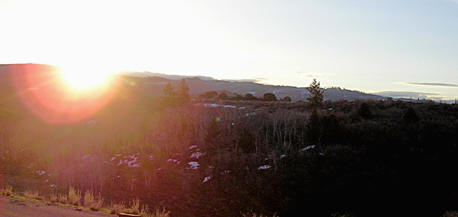 |
|
Sheep Creek Sunrise |
This is one of the routes where a Uinta National Forest road map would be most useful.
Drive east through Spanish Fork Canyon on US Highway 6 about twenty miles from the I-15 exit. There will be a small road sign indicating Sheep Creek Canyon turnoff to the north (left). It is about 25 miles from this junction to Strawberry Reservoir in Wasatch County. The roads are pretty good, but are not open during the winter. I have done one of my Breeding Bird Surveys on this route for more than fifteen years, and there are at least four, distinct plant community types with associated elevation increase that provide habitat for 40-45 species of birds.
The lower elevation is characterized by scattered juniper trees. Watch for Western Kingbird, Common Nighthawk, Mountain Bluebird, and Blue-gray Gnatcatcher. A couple more miles up the road and the habitat becomes a mixture of pinion-juniper and oak-maple that provides habitat for Virginia’s and Black-throated Gray Warblers as well as Ash-throated Flycatcher and Plumbeous Vireo. Drive another couple of miles and Great Basin Sagebrush, mingled with oak, becomes the dominant vegetation type with Green-tailed Towhee, Vesper and Brewer’s Sparrows. After another couple of miles the road drops in elevation and curves to the north. A small wet meadow with aspens to the east and oak brush to the left of the road hosts anywhere from ten-fifteen species at this one spot, so watch for House Wren, Black-headed Grosbeak, Red-naped Sapsucker, Yellow Warbler and Lazuli Bunting. After about another mile there is a road junction. Turn right (south) onto a gravel road. This road goes to Strawberry Reservoir. If you were to go on straight the road would eventually take you down to Springville Crossing and into Diamond Fork Canyon, one of the places I mentioned earlier.
At any rate, this road climbs higher in elevation, goes along a saddle providing great views down into Spanish Fork Canyon on one side and aspen covered slopes on the other. MacGillivray’s Warbler is common in this stretch (on the aspen side) as well as woodpeckers, juncos and kinglets. A little farther along I have found Red-breasted Nuthatches, Clark’s Nutcrackers and Townsend’s Solitaire. Eventually, the road forks. Take the left fork which is the road to Indian Creek. This goes through beautiful aspen forests before opening up into sagebrush flats and then finally into Strawberry Valley where the reservoir is located. Northern Goshawk has been sighted a couple of times along this Indian Creek road, so check out each raptor. Mountain Bluebirds are common as well.
A word of caution: the Indian Creek road was closed due to some construction work last summer, and at this time (mid-January) I do not know the status of the road. Check with the Spanish Fork Ranger District office before attempting to go all the way through.
Soapstone Basin (Wasatch County)
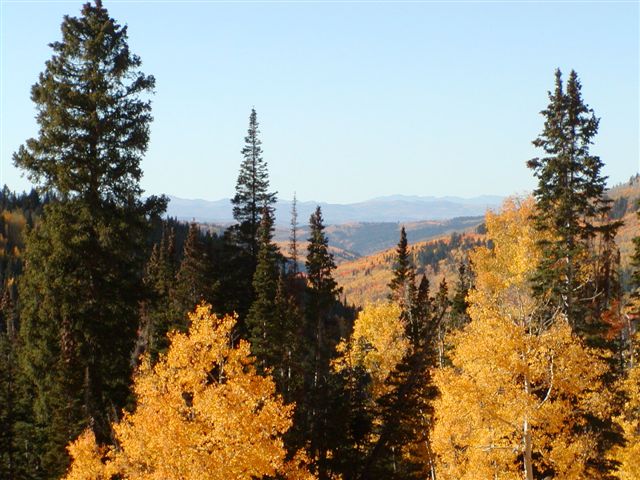 |
|
From Wolf Creek Pass looking towards
Soapstone |
To access the road to Soapstone Basin travel east from the town of Kamas (Summit County) on the Mirror Lake highway (#150). After about half an hour watch for a large pull-out area with some information signs. This is the road that goes south into the basin. This road is another one of my Breeding Bird Survey routes, and regularly produces a variety of high elevation species as well as some interesting riparian species. As the Provo River is crossed watch for the American Dipper and listen for Swainson’s Thrush. This is a fairly good gravel road, but is not open to through traffic during the winter. During the summer the high mountain meadows are full of wild flowers making the basin one of the most beautiful areas in the state to drive through. Birds along the route are Broad-tailed Hummingbirds, Pine Siskin, Olive-sided Flycatcher, Mountain Bluebird, Red Crossbill, Vesper Sparrow, Fox Sparrow, Lazuli Bunting, Western Wood-Pewee, Hermit Thrush, Green-tailed Towhee, and Macgillivray’s Warbler. Once you leave the basin and drive south towards the Wolf Creek highway the road goes through aspen and then spruce forests. Watch for Red-breasted Nuthatch, Red Crossbills, Pine Grosbeaks and American Three-toed Woodpeckers. When you reach the junction the road is paved. Turning left will take you to Wolf Creek Campground, another good place for the three-toed woodpecker. Turning right will take you down to Woodland, Francis, and then back to Heber City. Either way the road passes through beautiful spruce-fir forest with a nice mix of aspen.
South Willow Canyon (Tooele County)
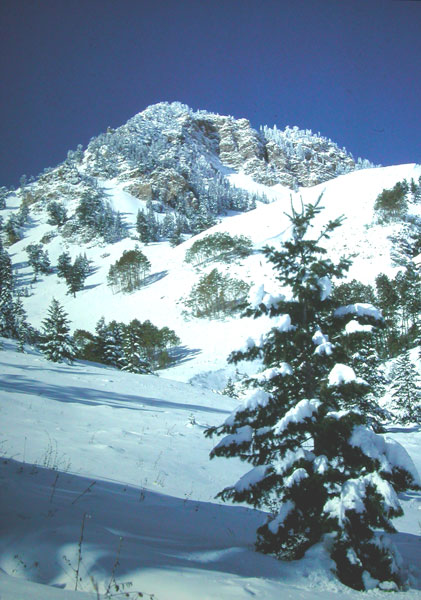 |
|
Early October Snow, South Willow
Campground |
Probably the easiest way to access this canyon is to travel to the west side of the town of Grantsville in Tooele County and then take the road south toward Saint John. You will travel through Gt. Basin Sagebrush for about ten miles (watch for Long-billed Curlew) and then take the road to the right (west) that goes to South Willow Canyon. The mountain range to the west is called the Stansbury Mountains. These are the beginning of what is called the “basin and range” province that extends westward across the Great Basin Desert to Reno, Nevada. These “island” mountains with associated vegetation provide habitat for an interesting variety of birds. The Stansburys are especially attractive to fall migrants, and some interesting warblers have been recorded in South Willow Canyon including Nashville, Townsend’s, Black-throated Blue, Tennessee and Ovenbird . Summer residents include Hammond’s Flycatcher, Western Scrub Jay, Townsend’s Solitaire, Hermit Thrush, American Dipper (stream), Western Tanager, Mountain Chickadee, Red-breasted Nuthatch, Brown Creeper, and Clark’s Nutcracker (higher elevation along the trail). The campgrounds at higher elevations are administrated by the Wasatch National Forest so there is a nominal user fee.
This completes my top
twenty. If I were naming 25 I would have added the area around Brighton, the
Raft River Mountains, Flaming Gorge Reservoir area, the Skyline Drive east of
Fairview and the Alpine Loop on the slope of Mt. Timpanogos. But, enough is
enough. By visiting the twenty locations I have mentioned the observer would be
able to list somewhere between 250 and 275 species in Utah. By visiting these
places regularly during the last 27 years I have averaged 275 species. So it is
doable.
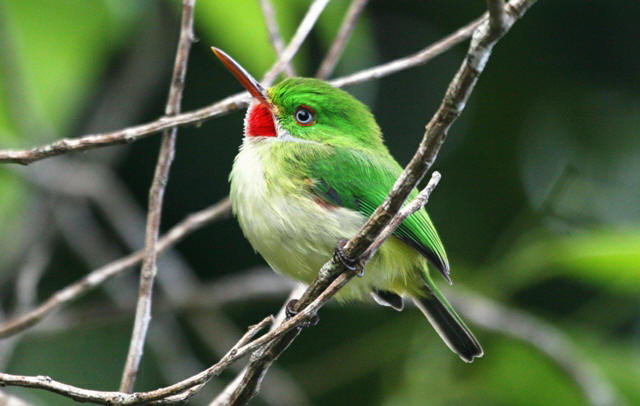 |
|
Jamaican Tody - Todus
todus |
Jamaican, Puerto Rican, Cuban, Hispaniolan Todies
Todus sp.
by Dennis Shirley
I picked this small group of birds for this months bird-of the-month because at the moment they are my favorite birds. Oftentimes as birders we are asked what are favorite bird is. My answer is usually the last good bird I’ve seen, most often a new life bird. Such is the case right now with the Tody. I just returned from a five day trip to Puerto Rico, where I met my son Darren, who was there on a business trip. I was also in Jamaica last fall with Bryan on a birding tour. On each trip I saw the endemic Tody species of that island. There are only five species of todies in the world. All are found only on their respective islands of the West Indies/Caribbean Islands of Jamaica, Puerto Rico, Cuba, or Hispaniola[2]. I realize most of us birders have never seen a Tody or for that matter even know much about them. I sure didn’t until my recent chances to visit these areas. That will change if you go there. They are one of the more common birds on any of the Greater Antillean Islands. They are found in most forested areas from lowlands to higher elevation rain forests.
Todies are tiny, about four inches long, and can momentarily remind one of a hummingbird. They often have a wing whirring sound on their short, quick, flight burst. They also remind me of a miniature kingfisher, and in fact they are a family in the bird order Coraciformes, which includes kingfishers, motmots, bee-eaters, rollers, and hornbills.
The five Tody species look quite similar, have bright iridescent green upper parts, a carmine-red
throat and lower bill, a white mustache stripe, and varying amounts of white, yellow, and pinkish on the breast, belly and undertail coverts. They have a short stubby tail and a relatively long, straight pointed bill, which is horizontally flattened, similar to the flycatchers.
Todies are primarily insect eaters and will sit quietly on a low perch with their pointed bill tilted upwards and slowly scan the understory of low level forest vegetation for their prey. They have a unique feeding niche, utilizing the undersides of leaves and branches to catch insects. Quickly it will fly up under the vegetation , grab an insect, and fly back to a new perch. It repeats this process time after time throughout the day. It is a voracious eater and can consume 40% of its weight in a day. When feeding young at a nest site up to 140 feeding trips per chick per day have been measured. Commonly, additional non-nesting adults will assist in feeding the young at a nest site. Its not hard to see why this specialized adaption has evolved, with so much energy expended by the nesting pair. Todies have one of the highest feeding rates ever recorded for insectivorous birds.
Todies excavate a one to two foot tunnel in a steep stream bank or road cut which leads to a small nesting chamber. They use their small feet and bill to dig the tunnel and nest site. They lay two to four shiny white eggs which are incubated 21 days. For its small size each egg is huge. Each egg is equivalent to one fourth of the body weight of the female, proportionally more than twice as heavy as most birds.
Another unique adaption todies have is their ability to lower their body temperature as much as 11 degrees C [20 degrees F] during times of cold weather on incubation to conserve body heat.
So the next time you are passing by the Caribbean don’t just plan to soak in the rays, listen to reggae music, and eat jerked chicken. Go find one of these real Jewels of the Islands.
Field Trip Report
Farmington Bay - 16 Feb 2008
by Lynn Garner
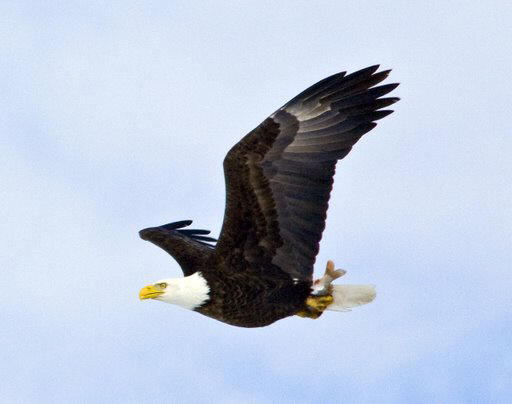 |
|
Bald Eagle with a delicious Carp - 16
Feb 2008 |
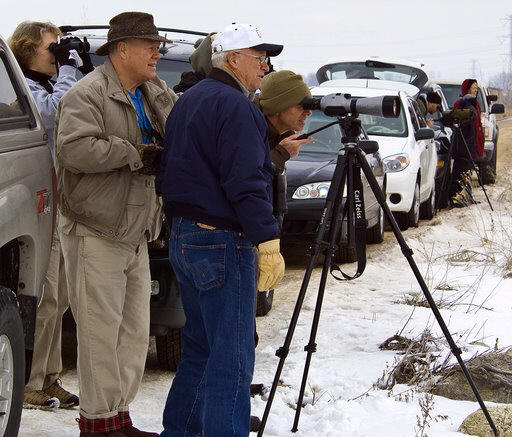 |
|
Birders birding at Farmington Bay - 16
Feb 2008 |
Nineteen birders gathered at Sam's Club parking lot in Provo for the trip north to Farmington Bay. Because the shortest route is blocked by the closing of Glover's Lane over Interstate 80, we didn't all take the same route. Consequently, not all saw the same birds. En route, about half of us found a flock of 250 Bohemian Waxwings sitting in a tree next to a Red-tailed Hawk, just south of the closed portion of Glover's Lane.
We did all arrive at Farmington Bay about the same time and shared most of the sightings there. The cold was quite intense and there was little open water, mostly at the first bridge and the large turn- around area. Highlights were a flock of 150 Tundra Swans and 50 Canvasbacks at the first turn and a total of 73 Bald Eagles. We looked in vain for unusual gulls; there weren't very many to look through. We spotted a Barn Owl and five Greater Yellowlegs at the turn-around.
Then we all moved on to the Kaysville Ponds. The highlights there were Hooded Mergansers and a few more gulls to scan. We separated for the trip home just before noon.
Lu Giddings was the leader of the field trip. Other participants were Glen Barlow, Thaylene Barrett, Ned Bixler, Andrew Brown, Bart Carter, Yvonne Carter, Lynn Garner, Doug Gittings, Kit Giddings, Eric Huish, Matt Mills, Stephanie Nolasco, LeIla Ogden, DeLoy Pack, Tuula Rose, Dennis Shirley, Merrill Webb, and Bonnie Williams.
The complete list of birds seen by members of the group follows: Canada Goose, Tundra Swan, American Wigeon, Mallard, Norther Shoveler, Northern Pintail, Canvasback, Redhead, Lesser Scaup, Bufflehead, Common Goldeneye, Hooded Merganser, Common Merganser, Ruddy Duck, Ring- necked Pheasant, Pied-billed Grebe, Great Blue Heron, Bald Eagle, Northern Harrier, Red-tailed Hawk, Rough-legged Hawk, American Kestrel, American Coot, Greater Yellowlegs, Ring-billed Gull, California Gull, Herring Gull, Rock Pigeon, Barn Owl, Black-billed Magpie, American Crow, Common Raven, American Robin, European Starling, Bohemian Waxwing, White-crowned Sparrow, Red-winged Blackbird, and Western Meadowlark, a total of 38 species.
2008 West Nile Virus (WNV)
Update
by Julia B. Tuck
In the past, we have been warned about going out at dawn or dusk, because this is when mosquitoes, the species of mosquito that carries West Nile Virus, flourish- and bite.
I had the opportunity this January to attend the 2008 Utah Green Conference and attend one of Dr. Howard Deer’s classes. He is the USU Extension Pesticides & Toxicology Specialist. So, here is the newest information on the West Nile Virus:
For every reported case of West Nile Virus, where the person is sick enough to receive medical attention, there are 149-150 cases that go unreported. They get sick but recover after 3 or 4 days.
In 2005, there were 56 cases reported in Utah (x 150 = 8,400 cases)
In 2006, there were 158 cases reported in Utah (x 150 = 23,700 cases)
In 2007, there were 68 cases reported with 2 deaths (68 x 150 = 10,200 cases)
The Corvids are the most efficient species at growing the virus. The 2nd tier of birds to carry the WNV are falcons, owls, and hawks.
Now, here comes the important part:
Each mosquito bite causes an inflammatory response which reduces the body’s ability to fight the WNV. If you receive 9 mosquito bites, you have increased your risk if one on them contains the WNV. Therefore, we need to be concerned with all of the mosquitoes, including the mosquitos that bite during the day (such as the treehole mosquito- Aedes sierrensis) as well as the species that bite at dawn and dusk (such as the "house" mosquito- Culex pipiens- which carries the WNV).
Products which are effective against mosquitoes::
DEET (N,N_diethyl_m_toluamide)- a product containing 23.8% DEET provides an average of 5 hours of protection
Picaridin (KBR 3023)
Permethrin- some formulations are registered for use on clothing, shoes, bed nets, and camping gear
So, my dear friends- take along your mosquito repellent when you are birding! "Friends don’t let friends get bitten."
Backyard Bird of the
Month
February 2008
Steve Carr - Holladay
Red-breasted Nuthatch - Two of them off and on every day.
Yvonne Carter - Highland
Feb 7th A.M. was unbelievable! 7-8 Steller's Jays were around. After filling the
feeders, 4 Scrub Jays flew in while over 15 Juncos and 8-10 Chickadees watched
from the trees, 10+ House Finches, 3 Red Winged Blackbirds appeared, and after
they all had a turn at the feeders, in flew in a Spotted Towhee. All within
15-20 minutes.
Flora Duncan - Orem
Mourning Dove - One sitting in
the yard. I didn't expect one this time of year.
Lynn Garner - Provo
With the return of the sun, the Spotted Towhee is now singing his territorial
call.
Eric Huish - Pleasant Grove
Golden Eagle - pair flew over.
Milt Moody - Provo
Hermit Thrush - on the last day of the month.
Carol Nelson - Provo
A Brown Creeper, creepin' up my pine.
LeIla Ogden - Orem
Two Bald Eagles flew over my house yesterday. A new yard bird.
Dennis Shirley - Elk Ridge
11-California Quail at the feeders up until yesterday. Now I have only 10
plus one Sharp-shinned Hawk.
Reed Stone - Provo
On the 15th of Feb. two Brown Creepers were working their way through our trees.
Alton Thygerson - Provo
Bohemian Waxwing - one in a small flock of Cedar Waxwings in a crabapple tree.
Bonnie Williams - Mapleton
Three Cassin's Finches - On the Great Backyard Bid Count.
We would like you to share your favorite backyard bird each month. Please send
your favorite bird at the end of the month to newsletter@utahbirds.org or call
360-8777.
UCB Membership Directory
If you would like a UCB Membership Directory E-mail newsletter@utahbirds.org . Not to be used for spamming.